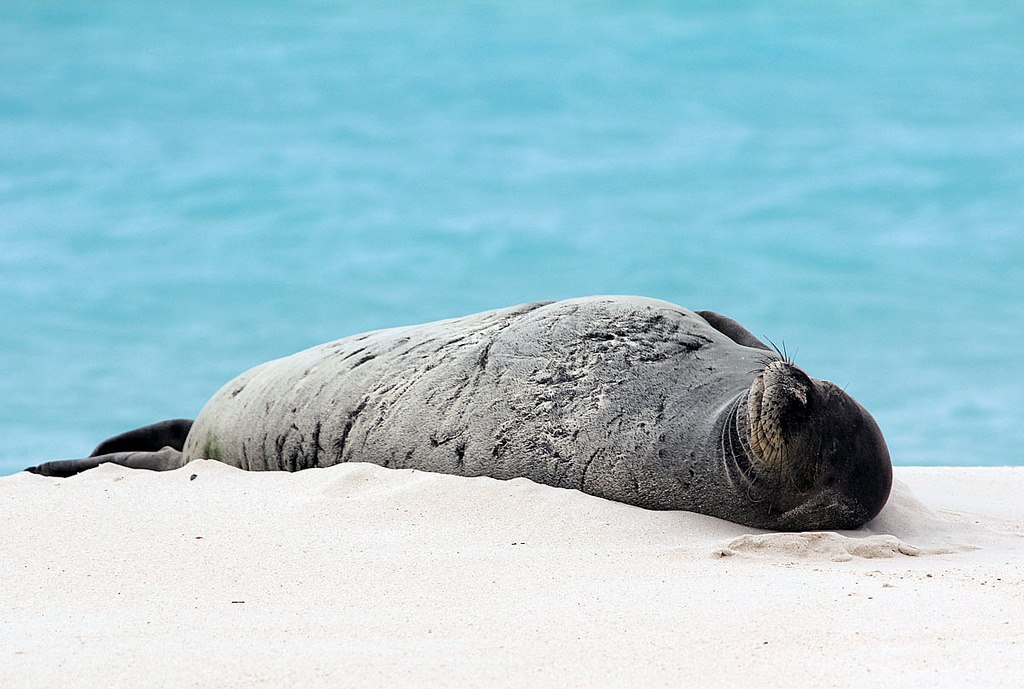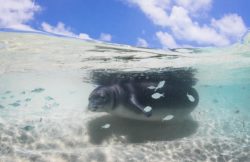
Hawaiian Monk Seal – An Endangered Marine Species

The Hawaiian monk seal is endangered, having been hunted almost to extinction in the 19th century, with only about 1,200 individuals at last count in 2016 in their native habitats in the Hawaiian Islands. One of their closest relatives, the Caribbean monk seal, went extinct in the 1950’s and the Mediterranean monk seal may be headed for the same fate, with only around 600 individuals remaining. Luckily, national marine sanctuaries and marine national monuments play an important role in protecting species like the Hawaiian monk seal.
Monk seals – a short background:
Scientific name: Neomonachus schauinslandi
Hawaiian name: ‘Ilio-holo-i-ka-uaua’ (literally: “the dog which runs in rough waters”)
What they are: Monk seals are members of the class pinnipeds (including other seals and walruses)
Size: Monk seals average around 7 – 7.5 feet long and can weigh an average of 375-450 pounds
Where they live: Hawaiian monk seals occupy a relatively small segment of the archipelago along both the main Hawaiian Islands (MHI) and the Northwestern Hawaiian Islands (NWHI), including Papahānuamokuākea Marine National Monument and Hawaiian Islands Humpback Whale National Marine Sanctuary. They spend most of their lives in the sea but will come out on land to give birth and raise their pups as well as spend time resting.
What they eat: Fish, cephalopods (octopus and squid), shellfish and other crustaceans.
Why are they named “monk” seals? They were given the name due to the folds of fur around their necks, which resemble the hooded cowls of a monk’s robe. In addition, like their human monk counterparts, they tend to be solitary rather than form the social groups typical of most pinnipeds.
Why are monk seals endangered?
The reasons monk seals have become endangered, especially in the NWHI, are not fully understood due to the logistical difficulty and expense in sending expeditions to the more remote islands of the NWHI. What is known is that there are multiple factors affecting seal populations, including:
habitat loss to human development, including dumping of pollutants into the seals’ habitat within coastal waters,
viruses and toxins
fishing equipment, especially nets and hooks
challenges in pregnancy and raising offspring
Habitat threats or loss
Coastal development and rising sea levels have reduced the areas available for birthing pups and resting as seals tend to spend almost a third of their time on land. Leaving the seals to breed or rest undisturbed is critical to their wellbeing.
Diseases
Several diseases have decimated the seals in recent years including toxoplasmosis and leptospirosis, partly due to inland water runoff from development, which have killed a number of seals. Other viruses in the morbillivirus family can pose severe threats to monk seal populations.
Human activity, especially fishing
While the populations around the main islands are recovering, the NWI area populations may still be dwindling, due partly to commercial fishing, where animals have become entangled in nets or caught on hooks, as well as diseases and poisonings from runoff.
Challenges for seal mothers raising pups
Male seals have been known to attack females in estrus during mating season, with some females having died from injuries. Because of the challenges posed by habitat reduction and food scarcity, most females are unable to reproduce each year. Due to insufficient food, habitat and diseases many seal pups never make it to adulthood in sufficient numbers to replace older animals.
What’s being done to help?
Public outreach and education are making a positive difference in stabilizing and raising monk seal populations Changing the attitudes and behaviors of the public as well as educating commercial fishing and development ventures about the dangers of nets, hooks, runoff and dumping is fundamental to successfully stabilizing the monk seal populations.
You can help, directly or indirectly: for example, if you’re on a beach where there are seals, most experts recommend staying at least 50 feet away from the animals to avoid stressing them. Fun fact: all marine mammals in the United States are protected by the Marine Mammal Protection Act, which prohibits harassing, feeding, or approaching marine mammals in the wild.
You can also help by making choices that prevent marine debris no matter where you live! These choices can include refusing single-use plastic water bottles, recycling, properly disposing of fishing line, using reusable shopping bags, or picking up trash that you see on the ground.
Outreach by volunteer organizations patrolling beaches, rescuing and rehabilitating animals and removing debris have also helped monk seal populations, especially around the main islands.
Hawaiian monk seals are a long way from being ready to leave the critically endangered list. The National Marine Sanctuary Foundation is committed to protecting Hawaiian monk seals and other endangered marine species, helping them to again thrive in an environment free from habitat loss and harm. To learn more about these amazing animals and recovery efforts, visit NOAA’s National Marine Fisheries Service.

Hawaiian Monk Seal Pup in Papahānaumokuākea Marine National Monument. Photo: Koa Matsuoka
